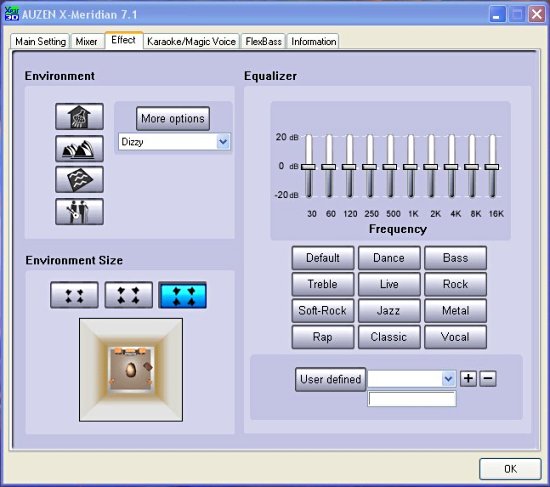

Was (and still is) a faction of music lovers and audiophiles who prefer to
#DSP MODE EX XEAR 3D VS DOLBY HEADPHONE PRO#
Was eight years before Dolby Pro Logic was launched. These two processors were introduced way back inġ978, and they were both based upon the Tate chipset. Space & Image Composer far superior to Pro Logic on stereo music sources,Īs well as on most movies. Playing movies, I found Jim Fosgate’s Tate 101A and Charlie Wood’s Audionics In its implementation, and not very exciting. The original Pro Logic was very conservative Worked okay on movies, nailing the dialog to the center of the screen, it was The attack and release times of the steering logic were slowed down to Left and right channels, and it still had a bandwidth-limited single rearĬhannel. It derived a center channel to go with the Stereo surround channels was far superior for listening to music in surroundġ986, Dolby Pro Logic was launched.


Was simply “better than nothing,” having an active matrix and full-range,
#DSP MODE EX XEAR 3D VS DOLBY HEADPHONE MOVIE#
Worked fairly well on music and stereo movie soundtracks. The imaging wasĭramatic, but not seamless and not without annoying audible artifacts. Previous to this same period, I was selling and installing systems thatĪctual steering logic, and full-range, stereo rear channels. Separation between front and rear channels was about 3 dB not very It was a primitive matrix that had three frontĬhannels and a single surround channel, often split into two rear surround This was essentially the beginning of home theater. Around 1984, VCRs were not only stereo, butĪlso hi-fi, and a very satisfying surround field could be generated from a Was only after the advent of the stereo VCR that movies at home could beĮnjoyed in surround sound, as primitive as it was. Cassettes often had phase issues that messed up the surround matrix. Surround sound, the source material we played was stereo music from records or (later)ĬDs. Stereo signal and generated (processed) a three, four, or five channel surroundįield from those two channels. Surround sound units themselves were called “processors” because they took a Was fortunate enough to have worked with some heavyweights in the area ofĪnalog surround from the 1980’s and on. Little surround sound history…music preceded movies in the home surround market… The time, but there are times when it really works well. I don’t listen in surround the majority of Would never listen to stereo music in surround. I fully realize that many of you who consider yourselves purists True surround sound processed from a stereo source, however can be The result wasĪlways hideous, but at least, technically, there were now two differentĬhannels. Reduced in one channel, and treble was reduced in the other. “Duophonic” was a process used in the ‘60s and ‘70s whereĪ monaural recording was split in half, and one channel was delayed, bass was Referred to multi-channel surround sound gleaned from a 2-channel stereo sourceĪs “fake stereo.” Actually, “fake stereo” was a real thing, and it had nothing To authenticate surround sound that is encoded and then decoded. Next I noticed that the piece only seemed For one, the articleĭealt almost entirely with motion picture surround technologies, and it barely I started to notice a few areas where he and I disagreed. While marveling at the author’s considerable expertise on the subject, I was reading a white paper on surround sound, because, let’s face it, I have Some of your stereo recordings in surround sound… Have recently upgraded your system, this might be a good time for you to try With surround sound decoding technologies like DTS:X and Dolby Atmos today's 3D sound technologies are, putting it mildly, spectacular! If you Sound processing for stereo music has been around since the early ‘70s and itĮven survived the quadraphonic era.


 0 kommentar(er)
0 kommentar(er)
